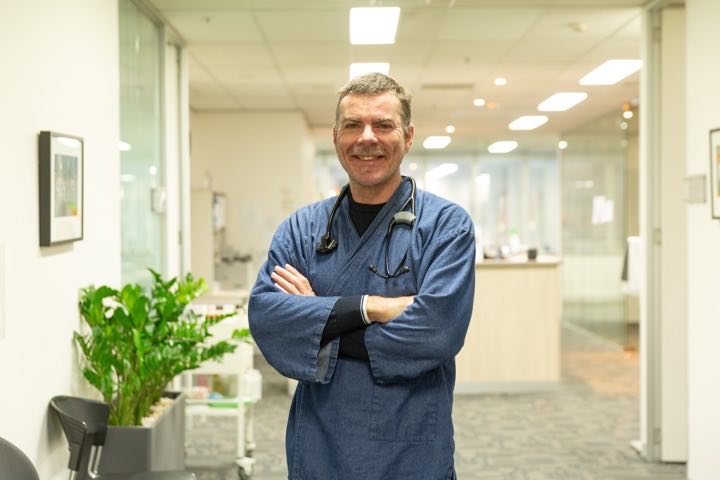
Could your snoring indicate something more sinister?
I want to talk about a topic that is very common and rarely diagnosed, despite the huge improvement in health that can come from treatment.
Do you snore? Do you frequently feel sleepy during the day? Has your partner or
significant other ever said you stop breathing at night?
If you have any of these three common symptoms you may be suffering with sleep apnoea, a disease where, due to a variety of reasons, the throat and upper airway can close, leading to people stopping breathing.
By definition an apnoea episode is when someone stops breathing for more than 10 seconds. In reality, many people stop breathing for 30 seconds or more.
Obstructive sleep apnoea (OSA) is a disease where breathing is greatly disturbed during the sleep process. Sleep apnoea is quite common, however, more than 80 percent of sufferers live their lives undiagnosed.
In most cases, sleep apnoea is caused by a combination of having a small airway, big tonsils and tongue, and lax support structures at the back of the throat. As sufferers sleep, their tongues fall backwards and block off the ability for air to flow through the mouth or nose into the lungs.
At this point, oxygen levels in the body start to plunge, and waste carbon dioxide levels start to rise. When the carbon dioxide levels reach a certain threshold the brain senses an emergency and wakes the person up to help start the breathing again.
If you have ever witnessed a partner having an episode this is normally the ‘snorky’ startling sound that is made after an extended period of not breathing.
Sleep apnoea sufferers go through repeated cycles of falling asleep, airway blocking off, stopping breathing and then waking up — sometimes more than 30 cycles per hour. This leads to very poor quality sleep and the body being forced to cope with very low levels of oxygen in the blood.
Doctors may consider a diagnosis of sleep apnoea with any or all of the following symptoms: daytime sleepiness; poor concentration and ability to think; low mood and irritability.
When suffered for many years, sleep apnoea can lead to organ damage and even changes in the blood to cope with long-term low oxygen levels.
Sleep apnoea has also been associated with high blood pressure and chronic stress on the body that makes weight loss difficult.
Who is at risk of sleep apnoea?
If you are a member of the Bear community you already have one of the risk factors — being male.
Increased weight is also a risk, with neck size being a major contributor. If your neck circumference is more than 43cm, you are at greater risk. However, slim people can also experience sleep apnoea.
Other risk factors include having a crowded space at the back of the throat, with large tonsils and tongue being the main cause. If you have ever had any damage to the facial bones, this can also be a contributing factor.
Having a blocked nose, even if you are able to breathe through it, doubles the risk of OSA. Smoking triples the risk.
Alcohol, because it tends to relax the muscles at the back of the throat, makes the risk of obstruction worse.
It is normally a sufferer’s partner who makes the diagnosis, reporting that their partner is frequently snoring and has episodes where they stop breathing.
If you think you may be suffering from OSA, check out the Epworth Sleepiness Scale. I suggest printing it out and sharing it with your doctor.
How is sleep apnoea diagnosed?
If you suspect you may be suffering with sleep apnoea, talk with your doctor. They are able to talk about what you have noticed, check your blood pressure and give you a brief physical exam. The gold standard to diagnose sleep apnoea is a sleep study.
A sleep study is normally done in a hospital setting. You will arrive in the early evening and you can expect to leave by about 7-8am in the morning. During your stay you will have your breathing, heart, and oxygen levels monitored as you sleep, to record episodes of apnoea as they occur.
If you have private health insurance this is normally covered. Discuss this with your provider if you are not sure.
There are home sleep studies available as well, however, it is uncertain how helpful the data from these studies are.
What is the treatment of sleep apnoea?
The best treatment for sleep apnoea is the use of a CPAP (Continuous Positive Airway Pressure) machine.
CPAP treatment consists of a machine and a mask worn while you sleep. While the inital adjustment can take a few days, many people report that the change is amazing.
Most people report feeling more energetic, with an increase in concentration and thought process. Daytime sleepiness is also reduced as the body returns to a normal sleep pattern.
Although there may be an initial awkwardness adjusting to the machine, most users are so happy with the result they can’t imagine living without it.
Other suggestions to help improve sleep include weight loss and avoiding alcohol at night, as this makes the upper airway and throat more likely to collapse.
The good news is that with treatment, sleep apnoea can be reversed and this can help improve energy levels, your ability to think and even help with blood pressure reduction and weight loss.
Certainly something to consider.
Dr GEORGE FORGAN-SMITH
Dr George blogs at: thehealthybear.com.au


[…] hours. As a result, any nose-clip, custom pillow, or other anti-snoring … Read More…Could your snoring indicate something more sinister? Do you snore? Do you frequently feel sleepy during the day? Has your partner or significant other […]
Well done on the article I think there needs to be much more open discussion on this and people should be out and proud about their snoring. So here I stand Snorer and Sleep Apnoea sufferer. I have had my CPAP machine for 12 days and already I am less sleepy during the day and am sleeping through the night. Yes the mask is weird and its strange sleeping attached to a machine, but if is going to drastically improve my quality of life – so have been told as I was stopping breathing 70 times an hour – then what does a minor inconvenience matter. You can even get a rebate on the cost of your electricity. Don’t be complacent get yourself checked out.